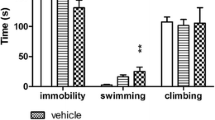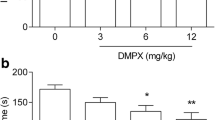Abstract
Midalcipran is a new potential antidepressant selected for its equipotent inhibition of noradrenaline and serotonin uptake and its lack of effect at any postsynaptic receptor. In mice it antagonized the depressant effect of tetrabenazine with an oral ED50 value of 0.5 mg/kg as compared to 2.5 mg/kg for desipramine and 5.1 mg/kg for imipramine. Similar findings were obtained for the inhibition of yohimbine-induced mortality. In the “behavioral despair” test, in mice, immobility was significantly reduced by 10 mg/kg midalcipran whereas 20 mg/kg of desipramine was required for a similar effect. Midalcipran enhanced the behavioral changes induced by 1-tryptophan in the rat and antagonized p-chloramphetamine-induced hyperthermia in mice. In contrast to tricyclic antidepressants, midalcipran showed no anticholinergic, sedative or stimulant properties.
Similar content being viewed by others
References
Briley M (1986) Midalcipran hydrochloride. Drugs future 11:21–23
Bourin M, Puech AJ, Chermat R, Doare L, Poncelet M, Simon P (1981) Profils psychopharmacologiques des nouveaux antidépresseurs comparés aux antidépresseurs classiques. Encephale VII:235–242
Brogden RN, Heel RC, Speight TM, Avery GS (1978) Mianserin: A review of its pharmacological properties and therapeutic efficacy in depressive illness. Drugs 16:273–301
Christensen AV, Fjallan B, Pedersen V, Dannes K, Samsoe P, Svendsen O (1977) Pharmacology of a new phthalane (Lu 10–17) with specific 5-HT uptake inhibiting properties. Eur J Pharmacol 41:153–162
Claassen V (1983) Review of the animal pharmacology and pharmacokinetics of fluvoxamine. Br J Clin Pharmacol 15:349S–355S
Dunham NW, Miya TSA (1957) A note on a simple apparatus for detecting neurological deficit in rats and mice. J Am Pharm Assoc 46:208–209
Everett GM (1967) The DOPA response potentiation test and its use in screening for antidepressant drugs. In: Garattini G, Dukes M (eds) Antidepressant Drugs. Excerpta Medica, Amsterdam, pp 164–167
Frances H, Chermat R, Simon P (1980) Oxotremorine behavioural effects as a screening test in mice. Prog Neuro-Psychopharmacol 4:241–246
Green AR (1981) Pharmacological studies on serotonin-mediated behaviour. J Physiol (Paris) 77:437–447
Heel RC, Morley PA, Brogden RN, Carmine AA, Speight TM, Avery GS (1983) Zimelidine: a review of its pharmacological properties and therapeutic efficacy in depressive illness. Drugs 24:169–206
Howard JL, Soroko FE, Cooper BR (1981) Empirical behavioral models of depression, with emphasis on tetrabenazine antagonism. In: Enna SJ, Malick JB, Richelson E (eds) Antidepressants, neurochemical behavioral and clinical perspectives. Raven, New York, pp 107–120
Kuhn R (1958) The treatment of depression state with G 22355 (Imipramine hydrochloride). Am J Psychiatry 115:459–464
Malick JB (1981) Yohimbine potentiation as a predictor of antidepressant action in antidepressants. In: Enna SJ, Malick JB, Richelson E (eds) Antidepressants, neurochemical behavioral and clinical perspectives. Raven, New York, pp 141–155
Menon MK, Vivonia CA, Kling AS (1984) Pharmacological studies on the antagonism by antidepressants of the hypothermia induced by apomorphine. Neuropharmacology 23:121–127
Moret C, Charveron M, Finberg JPM, Couzinier JP, Briley M (1985) Biochemical profile of Midalcipran (F 2207), 1-phenyl-1-diethyl- -aminocarbonyl-2-aminomethyl-cyclopropane (Z), hydrochloride, a potential fourth generation antidepressant drug. Neuropharmacology 24:1211–1219
Mouzin G, Cousse H, Bonnaud B, Stenger A (1983) Dérivés d'aryl-1-aminomethyl-2 cyclopropanes carboxamides, leur préparation et leur application en tant que medicaments utiles dans le traitement des troubles du système nerveux central. Eur Pat Appl EP 68999
Puech AJ, Frances H, Souto M, Chermat R, Simon P (1978) Problems of pharmacological screening for antidepressants. Neuropsychopharmacology 5:171–176
Porsolt RD, Bertin A, Jalfre M (1977) Behavioural despair in mice: a primary screening test for antidepressants. Arch Int Pharmacodyn 229:327–336
Sechter D, Poirier MF, Loo H (1984) Clinical studies with indalpine: a critical review. Clin Neuropharmacol 7:870–871
Serre c, Clerc G, Escande M, Feline A, Gineste D, Tignol J, Van Amerongen P (1986) An early clinical trial of midalcipran, a potential fourth generation antidepressant. Curr Ther Res 39:156–164
Squires R (1972) Antagonism of p-chloroamphetamine-induced depletion of 5HT from rat brain by some thymoleptics and other psychotropic drugs. Acta Pharmacol 31 (Suppl 1):35
Sugrue MF (1984) Antagonism of fenfluramine-induced hyperthermia in rats by some, but not all, selective inhibitors of 5-hydroxytryptamine uptake. Br J Pharmacol 81:651–657
Van Praag HM (1982) Neurotransmitters and CNS disease. Lancet 8310:1259–1264
Van Praag HM (1984) Studies in the mechanism of action of serotonin precursors in depression. Psychopharmac Bull 20:599–602
Van Praag HM, Westenberg HGM (1983) The treatment of depression with 1,5-hydroxytryptophan. In: Mendlewicz J, Van Praag HM (eds) Advances in biological psychiatry. Karger, Basel, pp 94–128
Wong DT, Bymaster FP, Horng JS, Molloy BB (1975) A new selective inhibitor for uptake of serotonin into synaptosomes of rat brain: 3-(p-trifluoro methyl phenoxy)-N-methyl-3-phenyl propylamine. J Pharmacol Exp Ther 193:804–811
Author information
Authors and Affiliations
Rights and permissions
About this article
Cite this article
Stenger, A., Couzinier, JP. & Briley, M. Psychopharmacology of midalcipran, 1-phenyl-1-diethyl-amino-carbonyl-2-aminomethylcyclopropane hydrochloride (F 2207), a new potential antidepressant. Psychopharmacology 91, 147–153 (1987). https://doi.org/10.1007/BF00217054
Received:
Revised:
Issue Date:
DOI: https://doi.org/10.1007/BF00217054




